How to Make Spaghetti and Meat Sauce from Scratch
Spaghetti and meat sauce is one of our family’s favourite meals. This recipe is endlessly customizable and always a crowd pleaser. Follow along for full recipe with lots of room for making it your own!
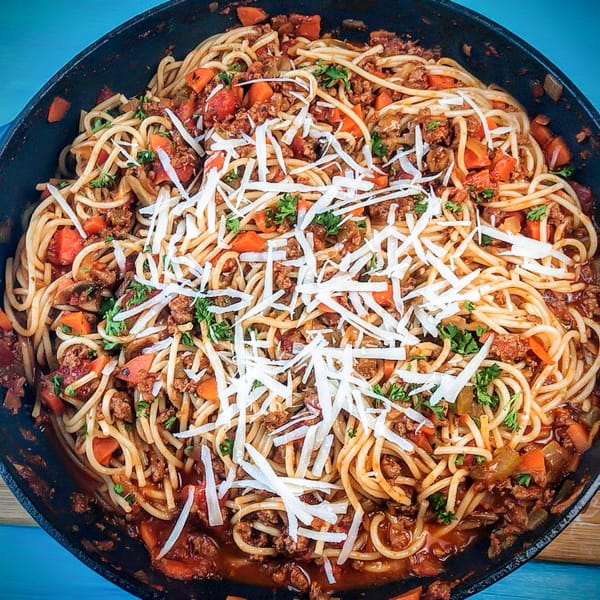
Read more: Homemade Sauce with Canned Tomatoes, Spinach Ricotta Pasta Bake, Creamy Chicken & Mushroom Pasta, Quick Easy Pesto.
Family Favourite with NO Recipe
It’s one of the meals we make without a recipe based on what we have on hand and taste testing along the way. Committing to a recipe was tough, but we put something in writing and have been testing it for the past six months. We’re confident you’ll love it too.
We offer this recipe as a starting point only. PLEASE make it your own. Taste along the way and add more or less of whatever you desire! Add cumin, add chili powder, add hot pepper flakes, mix in salsa – it’s all OK! Use whatever type of tomatoes you have. Don’t let anyone tell you what to put in YOUR sauce.
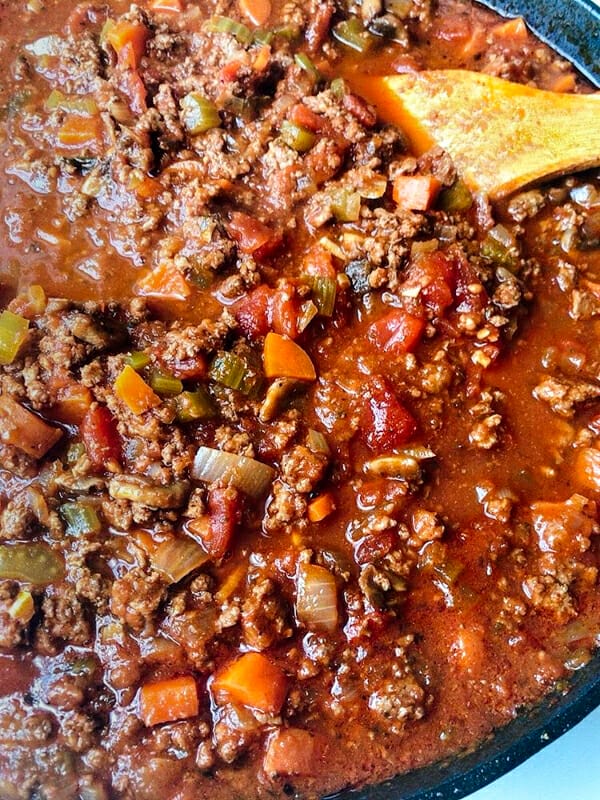
Recipe for Spaghetti and Meat Sauce
Spaghetti and Meat Sauce from Scratch
Ingredients
- 1 Tbsp canola oil
- 2 lbs lean ground beef
- 1 onion, diced
- 3 celery stalks, diced
- 3 carrots, diced or shredded
- 4 cloves garlic, minced
- 1/2 lb mushrooms, diced (10-12 mushrooms) optional
- 2 Tbsp Italian seasoning see notes
- 1 tsp salt
- 1/4 tsp black pepper
- 1/4 tsp cayenne pepper
- 1-2 Tbsp sugar as needed
- 1/2 cup tomato paste
- 1 cup beef stock
- 1/4 cup red wine or 2 Tbsp red wine vinegar
- 1 Tbsp Worcestershire sauce
- 1 can diced tomatoes 28 oz/796ml
- 1 can tomato sauce 14 oz/500 ml
- 1/2 cup fresh shredded Parmesan
Spaghetti
- 16 cups water
- 1 lb spaghetti noodles (makes 8 cups cooked)
- 2 Tbsp salt
Instructions
- Heat pot or dutch oven over medium high heat for 1 minute.
- Add oil to pan and heat for 30 seconds.
- Add ground beef and flatten as much as possible. Do not stir. Sear one side until golden brown, flip and sear other side. Break up into pieces and cook until no pink remains.
- Drain off liquid if needed.
- Add onions, celery and carrots; cook until softened and onions are translucent, about 3-5 minutes.
- Add garlic and mushrooms; cook another 2-3 minutes.
- Add Italian seasoning, salt, black pepper, cayenne pepper and sugar. Cook until fragrant, about 1 minute.
- Add tomato paste, beef stock, red wine or red wine vinegar, Worcestershire sauce, diced tomatoes and tomato sauce. Mix well and bring to boil. Reduce heat to low simmer, cover and let cook for 60 minutes to 3 hours, stirring occasionally. The longer you can let it cook, the more flavorful it will be.
- Taste and adjust seasoning. Every batch will be different so taste and adjust salt, sugar, wine, seasoning, etc.
- If sauce is too thick, add reserved pasta water. It will thin the sauce, but due to the starch from the pasta, it won't separate into a watery pool.
- Serve with shredded Parmesan cheese on top.
Spaghetti
- Bring water to boil in big pot. Lots of water will help prevent sticky pasta.
- Add salt to water to flavor the noodles. Do not add oil as this will prevent sauce from sticking to pasta once it's cooked.
- Measure 2 oz or 56 g of dry spaghetti for each person – more if you have big eaters! See full blog post for more about measuring spaghetti.
- Add spaghetti to boiling water and stir right away to separate the noodles.
- Boil uncovered for 6-8 minutes or as indicated on your package.
- At 6 minutes, lift a noodle out of the pot to feel and taste for desired doneness. Al dente is when pasta is tender but firm. If you like it softer, cook slightly longer. Pasta will soften a little while resting.
- Keep 1 cup of cooking liquid for use in spaghetti sauce, then drain the rest.
- Lightly and quickly loosen the pasta by jostling in the strainer. Toss with half the sauce and serve as an assembled dish with grated Parmesan on top. Or, serve sauce and spaghetti separately with shredded Parmesan on the side.
Notes
Nutrition Facts (per serving)
How Much Spaghetti To Make
While leftover sauce is easily frozen, leftover noodles do not freeze well. It’s okay to make a little extra for lunch the next day – but don’t make too much pasta. Here are some general guidelines to help you figure out how much spaghetti to make.
The serving size for the average eater is about 1 cup of cooked pasta, shown below.
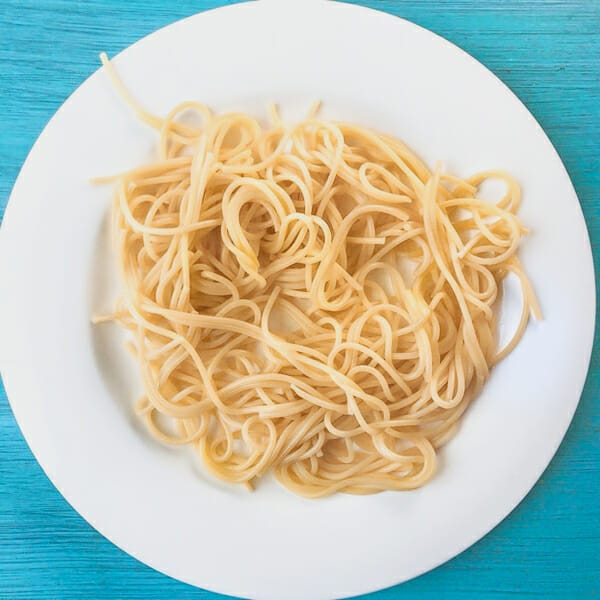
For 1 cup of cooked spaghetti, cook 2 ounces or 56 grams of dry spaghetti which looks like this. Add more or less depending on the crew around your table.
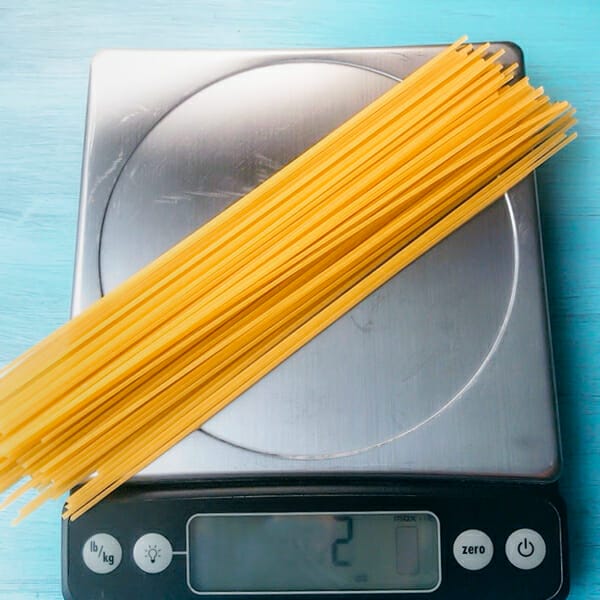
Other ways to eyeball how much spaghetti to cook for each person.
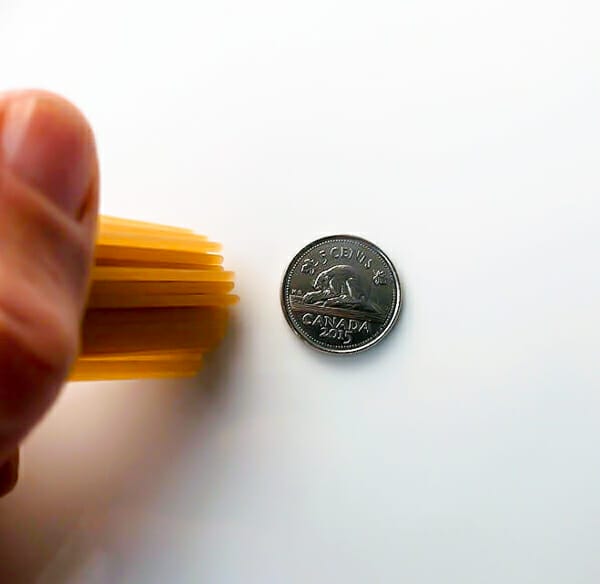
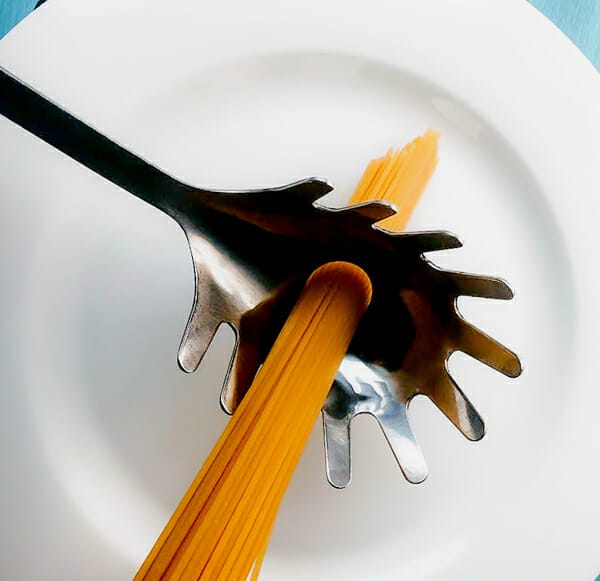
Tips & Ingredient Substitutions
Our number one tip for the most amazing sauce is to simmer for a long time. Oh sure, it’ll taste good after 45 minutes, but it will taste even better if you let it cook low and slow for at least 3 hours up to 5 or 6 hours.
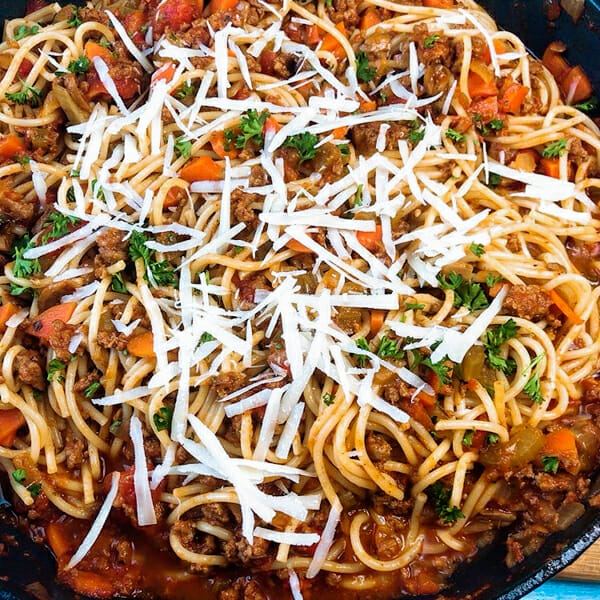
Actually, the best flavor and texture comes the following day. So if you can make your sauce one day before you serve it – you will have the best sauce ever!
With that little nugget to think about, let’s talk about ingredients and possible substitutions.
- Ground Beef. I usually use lean ground beef for my sauce. But use whatever you like – ground chicken, turkey, pork or sausage meat. Some of my best sauces have been when I use a combination of meat. For example 1lb ground beef and 1lb ground spiced pork sausage meat – my son’s all time favorite.
- Vegetarian Option. Of course, you can skip the meat and turn this recipe into a great vegetarian spaghetti sauce thanks to all the veggies. You could also replace the meat with extra mushrooms, cooked lentils or scrambled tofu or tempeh.
- Vegetables. I like adding veggies to spaghetti sauce and I don’t mind having bigger chunks. You can leave them out if you’d like or you can chop them super small, or puree them in a food processor to add bulk, flavor and nutrients to your sauce.
- Tomato sauce/Tomatoes/Tomato Paste. For a sauce like this canned tomatoes are actually better than fresh tomatoes. Fresh tomato pasta sauce is AMAZING, but uses a different technique than this recipe. So, use whatever type of canned tomatoes and sauce you have. We like diced tomatoes because they break down into small bites that even my non-tomato lover eats. Choose what works for you. I highly recommend adding some tomato paste because it does add body and thickness to your sauce – but hey, if you don’t have it – don’t let that stop you. Here’s a secret – we happened to be out of tomato paste when we made the sauce in these photos – do what you can with what you got!
- Beef broth & Worcestershire Sauce. I like these for the meatiness they add to the recipe.
- Red Wine or Vinegar. Red wine or vinegar added early in the cooking process is a magical ingredient that rounds out the overall flavor. It’s hard to describe the flavor difference, but there is a deeper, more robust flavor when you add them in.
- Dried Herbs. This is a long simmering sauce, dried herbs added early on really help to build flavor. I would not omit them, they’re key to the sauce. It’s okay if you don’t have one or two of the herbs listed, but you gotta have some. If you have fresh herbs like basil or oregano – fantastic! Add fresh oregano or thyme in the last 10-15 minutes of cooking. Save fresh basil as garnish to serve with the final dish. Fresh basil will turn black in a few seconds of being in a hot sauce. You’ll have a much more visually appealing dish if you garnish the final dish with basil just before you serve it. Or, have cut basil available for everyone to add to their own plate. By the time, the pasta gets on people’s dish, the temperature will be cool enough for the basil and you’ll get the benefit of all that fresh flavor.
Kid-Helper Friendly!
A family favourite recipe like this is best made together. I had such fun making this batch with my daughter and son (behind the camera). Spaghetti and meat sauce is one of the recipes the kids wanted to learn as part of their 6 meals by age 16.
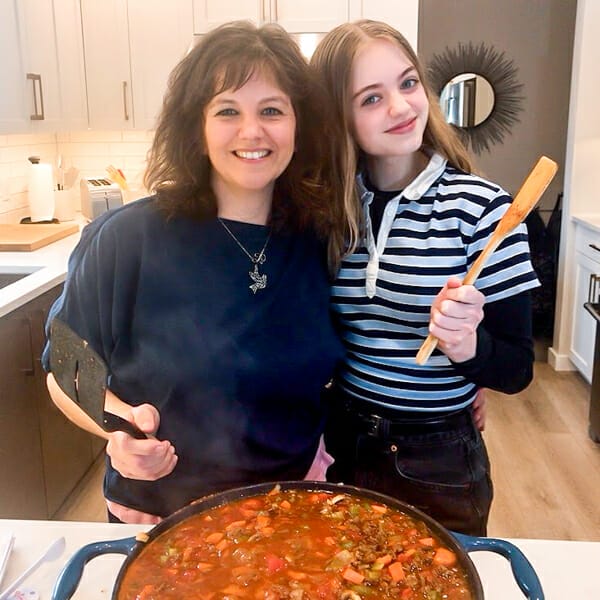
Here’s a video of us chopping the onions for this recipe.
If you make this recipe, write me a note or post a photo on Instagram with #getgettys so I can see it and like it!
Getty Stewart is a Professional Home Economist, speaker, frequent media guest and writer dedicated to putting good food on tables and agendas. She is the author of several recipe books on enjoying and preserving fruit, Founder of Fruit Share, a mom and veggie gardener. Sign up to get articles by Getty delivered to your inbox. You’ll get recipes, practical tips and great food information like this.


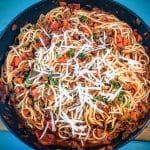
Grrreat! This is one of the best spaghetti recipes that I have read ever. I learned from my Italian nonna, zias, and father. I have been following their basic recipe for 50 years and your recipe is bang on. Dad would start the previous day or early in the morning by simmering a chicken stock. He like to finely chop the garlic, celery, onion, and carrots, but would leave some courser to last through the cooking process. Once these were added to the hot olive oil and began simmering, he would hit the mix with the wine. Bang, what a flavourful start. Adding the spices (including some bay leaves and a whole hot pepper or two) next with the chicken stock (up to an amount relative to the veggies and the desired volume). He would continue by adding the chopped tomatoes, then introduce as much tomatoe paste as viscosity required. He liked to cock the meat, usually hamburger in a separate pan. He chopped it down while cooking into small bites, adding more spices and oil as needed. He would add this to the sauce sooner or later depending on how meaty tasting he wanted the finish. Yes, simmering for 4 to 6 hours was usual. He would continue tasting the sauce, adding more spice, salt and oil as needed. Remove bay leaf and pepper! Remaining sauce was sealed while hot into quart jars and kept in the fridge to make caccaitore, lasagna, pizza over the next few weeks. The left over chicken? Delicious soup. Thx
Hi Brian,
Long and slow is the best way to build flavor!Thanks for sharing.
Getty